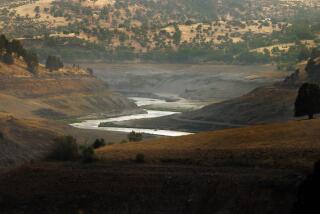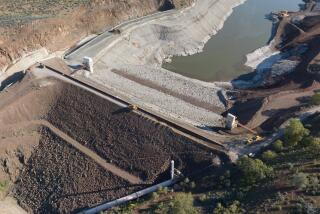Waters of Three Gorges Dam Will Wash Over World Culture
- Share via
In recent months, art, culture and history have disappeared or been destroyed -- first in Iraq and now in China.
The April looting of artifacts in Iraq and the fire at the national library and archives were disheartening not just because the United States chose to secure oil wells rather than protect thousands of years of culture but because the Iraqi people -- in a frenzy of anger, frustration and greed -- were the destroyers.
And in China, the devastation has come in another form. On June 1, after a decade of construction, China began to fill the reservoir for the controversial Three Gorges Dam on the Yangtze River. In 2009, when the final phase is completed and the reservoir is filled to capacity, more than 2,000 known archeological sites -- some dating to the Paleolithic era -- will have been submerged, and numerous historic buildings and anthropological sites and the beautiful Three Gorges will be at risk.
The Chinese government has long known where the archeological sites are but claims that it has not had the resources to protect them. Although the projected costs for the dam are in the billions (estimates range from $20 billion to $70 billion), only under international pressure did China allocate $135 million to preserve relics.
But insufficient money isn’t the only hindrance. One archeologist has estimated that it would take 500 years to excavate all of the sites properly; to date, only one-tenth of the known sites have been excavated.
In this vacuum created by a lack of resources, time and will, sophisticated thieves equipped with cell phones, radios and metal detectors have ransacked tombs from the Han through the Qing dynasties. As in Iraq, the failure of law enforcement has resulted in some farmers -- armed with shovels, pickaxes and sometimes the village tractor -- becoming emboldened enough to try their luck at looting. Some artifacts have already made it into the world art market. In 1998, a Han Dynasty bronze “spirit tree” -- believed to have come from the Three Gorges region -- sold in New York for $2.5 million.
Dealers and collectors argue they are acquiring these pieces as a way of preserving them. Given the shortage of time, perhaps it is better they have been saved rather than lost at the bottom of a lake. But should cultural artifacts and relics -- objects that give us keys to our collective past -- be hidden in the vaults of private collectors?
Historic monuments and buildings in the Three Gorges have presented some interesting preservation conundrums and a few wacky solutions. Some structures, such as the 1,700-year-old Zhangfei Temple, are being dismantled and moved to higher ground, while others, like the 12-story, 500-year-old Shibaozhai Temple and the White Emperor City, will be protected in situ by massive concrete dikes, creating modern islands with ancient architecture set at lower levels than the surrounding man-made lake.
The White Crane Ridge stone carvings -- the world’s first hydrometric station -- has proved to be one of the greatest challenges. This ancient navigation system cut into a sandstone ledge emerges only during dry season, revealing carvings and 30,000 characters of Chinese poems and comments that record 1,200 years of the Yangtze’s water history. To save the attraction, Chinese engineers have envisioned an “underwater palace,” with a pressure-free container covering the carvings on one side, the lake on the other and an enclosed underwater walkway in the middle.
But what about the unexplored sites? So much history is buried in China, and it is usually found by accident. A farmer digging in a field in 1974 discovered the famous “terra cotta warriors” of Xian. In 1984, in the village of Longgupo not far from the Yangtze, a farmer stumbled across a cave that had collapsed 2,000 years ago. Inside, anthropologists found 20 layers of bones, including those of many extinct species. But the most amazing discovery was a piece of human jawbone more than 1.8 million years old. The Longgupo hominid could be the ancestor of all Asian mankind.
And then there is the greatest loss of all. Even with the pollution along the river, the Three Gorges are one of the planet’s most magnificent masterpieces, having inspired countless poets and artists to reflect on man’s insignificance in the face of nature. The Chinese government promises that new, pristine sights will now be accessible, but the fact is that the gorges themselves will be diminished. The majestic Kuimen Gate -- a pair of towering cliffs flanking the river -- will now be reduced to two rather insignificant mounds.
Artifacts may be unique to a country or culture, yet these pieces of bone, stone, metal, wood and earth tell us not only where we came from as human beings but who we are today and what we can become tomorrow. These losses in China and Iraq may go quietly unmourned today, but their absence will ripple across the centuries.
More to Read
Sign up for Essential California
The most important California stories and recommendations in your inbox every morning.
You may occasionally receive promotional content from the Los Angeles Times.













